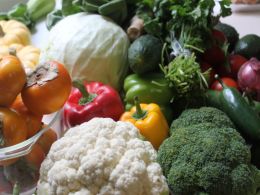Tips For Growing Your Own Vegetables
 Over the past several years, the food industry has seen vast expansion in the area of organic growth. Health experts often recommend choosing organic products when shopping for vegetables if you want to avoid chemical interference in food or possible genetic alterations. While consumers are more aware of the benefits of organic vegetables than ever before, the price of organic produce is not necessarily in line with the budget of the majority of shoppers. High prices have the ability to keep customers away from organic products, and sticking to lower priced and potentially, highly processed foods instead.
Over the past several years, the food industry has seen vast expansion in the area of organic growth. Health experts often recommend choosing organic products when shopping for vegetables if you want to avoid chemical interference in food or possible genetic alterations. While consumers are more aware of the benefits of organic vegetables than ever before, the price of organic produce is not necessarily in line with the budget of the majority of shoppers. High prices have the ability to keep customers away from organic products, and sticking to lower priced and potentially, highly processed foods instead.
If you feel strongly about buying healthy produce, but don’t necessarily have the funds to buy exclusively organic, growing your own vegetables is a great alternative option. While the prospect of gardening may seem a bit daunting, there are simple tricks that can a novice gardener growing like an expert in no time.
Garden according to your schedule
One of the factors that quickly discourage new gardeners is when the work involved in maintaining a productive garden is underestimated. Before you get started, it’s important to understand how vegetables grow and compare that information against your personal time restrictions and dietary goals.
Some vegetables such as Asparagus are perennial plants and take several years to fully develop. Other vegetables like tomatoes, can be produced in abundance with very little care, but must be replanted each year. Take the time to decide how much time you want to invest in growing your own vegetable garden, and how much yield you want to produce. This can save you a lot of time and alleviate a great amount of stress for first-time gardeners.
Stick to planting guidelines
Before you begin growing your own vegetables, it’s important to understand planting patterns. This will help you avoid a lot of stress and cross-pollination that can lead to mismatched flavors and tangled vegetables. Certain plants like tomatoes and peas are crawling vegetables whose vines grow upwards as the vegetables grow. Be sure to keep these vegetables away from low-lying plants that could be overshadowed by leaves that are more expansive. Vegetables that develop early on in the season such as carrots, onions or radishes can be grouped together but should be spaced generously apart to keep seeds, vines and potentially flavors from interfering with one another.
Incorporate tradition
An old vegetable gardening tradition has the potential to show big results in your modern garden. Try planting a small minnow or sardine next to each seed during seasonal planting. The small fish can act as an extremely effective soil fertilizer that will help your garden bloom and keep you gardening well into the future.
Don’t be afraid to ask for advice from veteran gardeners when it comes to growing your own vegetables. Making sure you know what you want to grow, how much and where to plant is essential before you get started. When your pantry is overflowing with fresh, organic produce grown by your own hand, you’ll be glad you did!
-
Advertisement

 Facebook
Facebook  Twitter
Twitter  RSS
RSS







